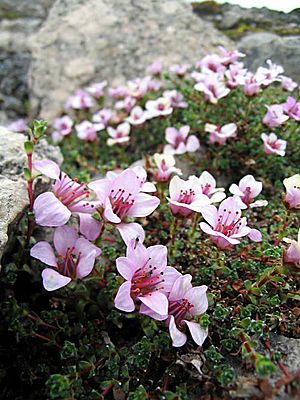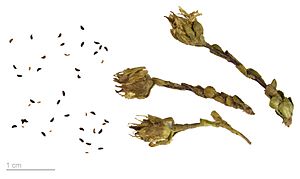Purple saxifrage facts for kids
Quick facts for kids Purple saxifrage |
|
|---|---|
 |
|
| Scientific classification | |
| Genus: |
Saxifraga
|
| Species: |
oppositifolia
|
The purple saxifrage, also known as Saxifraga oppositifolia, is a common plant found in the very cold Arctic regions. You can also spot it in high mountain areas further south, like northern Britain, the Alps, and the Rocky Mountains. It's a tough little plant that loves chilly places!
Contents
What Does the Purple Saxifrage Look Like?
This plant is a low-growing type, usually only about 5 centimeters (2 inches) tall. It often forms thick or loose mats on the ground. Its branches are a bit woody and tend to creep or trail along the surface.
The leaves of the purple saxifrage are small and round, like tiny scales. They grow in four neat rows, facing each other. The edges of the leaves have tiny hairs, which helps the plant in its cold environment.
Its flowers grow one by one on short stems. They are a beautiful purple or lilac color. The petals are much longer than the calyx, which is the green, leaf-like part that protects the flower bud. This plant is one of the first flowers to bloom in spring, and it can keep flowering all summer long in places where the snow melts late. Each flower is about 1.3 centimeters (0.5 inches) wide.
Where Does the Purple Saxifrage Live?
Cold Homes of the Purple Saxifrage
The purple saxifrage grows in many different cold places, from cool temperate zones to the very cold Arctic. You can find it from sea level all the way up to about 1,000 meters (3,300 feet) high. In some areas, it grows so much that it adds a lot of color to the landscape!
Its natural homes include the flat, treeless tundra, rocky coastal cliffs in the Arctic, and cracks in rocks in high mountains.
A Swiss plant expert named Christian Körner found this plant growing at an amazing height of 4,505 meters (14,780 feet) in the Swiss Alps. This makes it the highest-growing flowering plant in Europe! It even grows on Kaffeklubben Island in northern Greenland, which is the most northerly place on Earth where plants are found.
Animals and the Purple Saxifrage
Some animals like to eat the flowers of the purple saxifrage. For example, the caterpillars of the Gynaephora groenlandica, which are very good at living in cold places, enjoy munching on them.
How People Use Purple Saxifrage
Gardens and Food
The purple saxifrage is a popular plant for alpine gardens, which are gardens designed to look like mountain environments. However, it can be tricky to grow in warm climates because it prefers the cold!
The petals of the flowers are edible, meaning you can eat them! People, especially the Inuit in parts of Nunavut where berries are not common, eat them. They taste a bit bitter at first, but then they become sweet after about a second. They are also a little sticky. The Inuit people call this plant aupilaktunnguat.
The leaves and stems of the plant can also be used to make herbal tea. Many people from Nunavut say that the tea tastes best later in the season, after the flowers have finished blooming.
Symbols and Flowers
The purple saxifrage is an important plant in several places:
- It is the official territorial flower of Nunavut in Canada.
- It is a symbolic flower for the Nordland county in Norway.
- It is the county flower of County Londonderry in Northern Ireland.
Types of Purple Saxifrage
There are a few different types, or subspecies, of Saxifraga oppositifolia. Some of these include:
- Saxifraga oppositifolia ssp. glandulisepala Hultén – found in Alaska
- Saxifraga oppositifolia ssp. oppositifolia L. – found in the continental United States
- Saxifraga oppositifolia ssp. smalliana (Engl. & Irmsch.) Hultén – also found in Alaska
See also
 In Spanish: Saxifraga oppositifolia para niños
In Spanish: Saxifraga oppositifolia para niños


